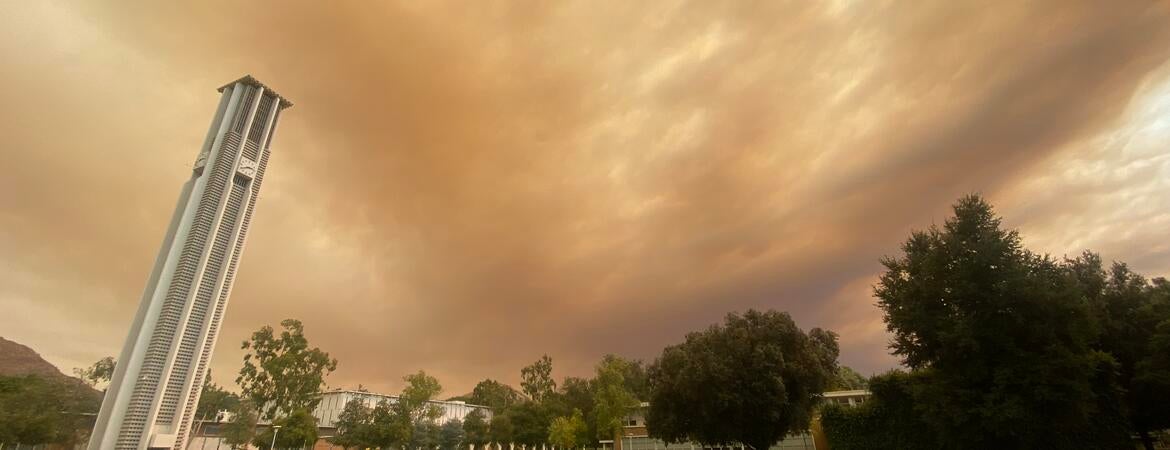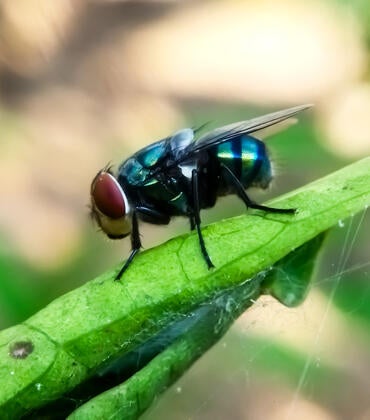
Several Southern California communities, including Riverside, are being hit with smoke from the huge Line Fire in the San Bernardino Mountains, creating what the Environmental Protection Agency classifies as “very unhealthy” air quality. UC Riverside experts on environmental pollution describe what we’re breathing, how long the airborne particles are likely to stick around, and what long-term effects they are having. Experts include:
James Gomez, Ph.D. candidate, Department of Earth & Planetary Sciences
Markus Petters, professor, Department of Chemical & Environmental Engineering
Roya Bahreini, professor of atmospheric science
William Porter, assistant professor, Department of Environmental Sciences
Francesca Hopkins, associate professor of climate change and sustainability
Q: What, specifically, is unleashed into the air during a wildfire?
James Gomez: Wildfires burn biomass such as grass, trees, and shrubs. As these fires combust the plant matter, the material in the plant undergoes chemical reactions with the surrounding air, which can produce a variety of products. These include trace gasses, most notably: carbon dioxide, carbon monoxide, and methane. The burning also releases particulate matter, including black carbon, organic aerosols, and sulfur dioxide. These particulates, as well as trace gasses such as carbon monoxide, when inhaled, can lead to a variety of negative health impacts.
Markus Petters: When biomass burns, the majority of the fuel makes carbon dioxide and carbon monoxide. A small fraction of turns in particulate matter with particle sizes of less than 2.5 micron in diameter, or PM 2.5. The median size of particles is approximately 0.1 micrometers. The particles are composed of a mixture of soot (or black carbon), some salts present in the plants, some partially combusted plant materials, some soil dust that is lofted with the fire, and some ash particles.
Q: Is the particulate matter consistent, or does the type and amount vary by fire?
James Gomez: Particulate matter varies wildly by fire. The amount, and type, of particulate matter, depends on what is being burned and how complete the combustion is. Large fires consume more biomass, and the more biomass that is burned, the more particulate matter you will have. Cooler fires will emit more aerosols, as black carbon is the product of incomplete combustion of hydrocarbons (which are found in plants). Hotter fires will emit more trace gasses. Additionally, the type of vegetation matters as well. Oily or sappy plants emit more organic aerosols than other plants. Therefore, burning pines or eucalyptus trees can result in more air pollution than burning something like grass.
Q: What are the health effects of the particles that get unleashed?
Markus Petters: The health effects of PM 2.5 have been well documented. I recommend the California Air Resources Board site for this. As noted there, short-term acute exposures, as is the case with wildfire, are associated with increased hospital admissions for heart or lung disease, bronchitis, asthma attacks, and respiratory symptoms. Mortality (the number of deaths per day) predictably increases during air pollution episodes.
Q: How long do particles unleashed by wildfire combustion tend to hang around?
Will Porter: In terms of timelines, wildland fire emissions can continue long after a fire is controlled or even largely extinguished, especially if there are pockets of smoldering. Without weather conditions that can clear things out (rain, mixing, transport to remote areas), fine particulates can also linger for days or even weeks, since it can take a long time for those tiny particulates to settle.
Roya Bahreini: The larger particles get to settle out more quickly, but smaller ones can linger and get transported far. Any precipitation can scavenge the particles and clear the atmosphere out. The South Coast Air Quality Management District has a lot of good information on this.
James Gomez: Fires can continue to smolder after they have been "extinguished". You can see this for yourself next time you go camping and start a fire. If you pour too little water on your campfire, you'll notice smoke continue to emanate from your fire pit for hours. There is not actually a fire occurring, but enough heat and fuel remains to continue the chemical reactions that release particulate matter and trace gasses.
Q: What are the long-term effects of the wildfire particles with respect to the environment?
Francesca Hopkins: If it’s a grassland like the hills behind the UCR campus that burned, most of the fire fuels are dead grasses that have only been “fixed” in the ecosystem for a year or less. If it's a forest, you are probably burning fine fuels such as dead needles or small branches. In these kind of fuels, the carbon has been fixed for a year or so. . If the fire is more intense, and trees burn, carbon that has been fixed in the ecosystem for decades can be released.
Carbon that has only been locked up for a short time (a year or less) is basically cycling on timescales where we consider it to not make much difference to the amount of greenhouse gas in the atmosphere.
When intense fires release older carbon, that is sending CO2 into the atmosphere that has been “locked away” for a long time. When carbon is fixed or locked up in plants, it’s not contributing to global warming, but when that carbon is in the atmosphere, it causes more warming, increasing fire risk and causing more high-intensity fires, which in turn release more carbon in the form of CO2 and methane which are both important greenhouse gases. That’s the doom loop.
More warming—> more fires—> more decades old carbon released—> more warming.
James Gomez: It is not only the emission of greenhouse gasses that can lead to more favorable conditions for fires. Previous studies have found that black carbon emitted from these fires can absorb sunlight and heat the atmosphere. This can lead to increased atmospheric warming and drying of the atmosphere both at and away from the site of the fire.
The drier conditions may reduce cloud cover and precipitation, which can lead to a feedback loop at the site of the fire and contribute to more favorable conditions for fires to occur elsewhere. Additionally, some fires create pyrocumulus clouds. On rare occasions, these clouds have produced lightning, which can ignite more fires.
(Cover image: David Danelski/UCR)



